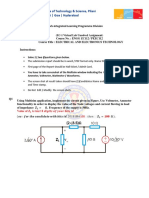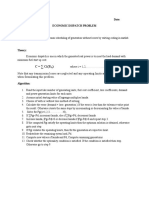34343
34343
Uploaded by
Anand KalCopyright:
Available Formats
34343
34343
Uploaded by
Anand KalOriginal Description:
Copyright
Available Formats
Share this document
Did you find this document useful?
Is this content inappropriate?
Copyright:
Available Formats
34343
34343
Uploaded by
Anand KalCopyright:
Available Formats
ECONOMIC DISPATCH IN POWER SYSTEMS
AIM:
To understand the fundamentals of economic dispatch and solve the problem by using Lambda-
iteration method without line losses and with generator limits.
SOFTWARE REQUIRED:
MATLAB
THEORY:
The goal of economic dispatch is to determine the generation dispatch that minimizes the
instantaneous operating cost, subject to the constraint that total generation is equal to the total
demand and losses.
FACTORS TO CONSIDER IN ECONOMIC DISPATCH PROBLEM
The Cost of Generation
Cost is one of the primary characteristics of a generating unit that must be considered when
dispatching units economically. The EDC is concerned with the short-term operating cost, which is
primarily determined by fuel cost and usage. Fuel usage is closely related to generation level. Very
often, the relationship between power level and fuel cost is approximated by a quadratic curve:
F = aP2 + bP +c.
c is a constant term that represents the cost of operating the plant, b is a linear term that
varies directly with the level of generation and a is the term that accounts for efficiency changes
over the range of the plant output.
The Price
The price at which an electric supplier will be compensated is another important factor in
determining an optimal economic dispatch. In many areas of the world, electric power systems have
been, or still are, treated as a natural monopoly. Regulations allow the utilities to charge rates that
guarantee them a nominal profit. In competitive markets, which come in a variety of flavors, price
is determined through the forces of supply and demand.
The Quantity Supplied
The amount of electric energy to be supplied is another fundamental input for the EDC. If a
consumer switches on a motor, the electric supplier must provide the electric energy needed to
operate the motor. In competitive markets, this obligation to serve is limited to those with whom the
GENCO has a contract. Beyond its contractual obligations, the GENCO may be willing (if the
opportunity arises) to supply additional consumer demand.
JJCET/EEE-Power System Simulation 38
Statement of Economic Dispatch Problem:
In a power system, with negligible transmission loss and with N number of spinning thermal
generating units, the total system load PD at a particular interval can be met by different sets of
generation schedules.
(K) (K) (K)
{PG1 , PG2 , … … … . . PGN }; K = 1,2, … … NS
Out of these NS set of generation schedules, the system operator has to choose the set of schedules,
which minimize the system operating cost, which is essentially the sum of the production cost of all
the generating units. This economic dispatch problem is mathematically stated as an optimization
problem.
Given: The number of available generating units N, their production cost functions, their operating
limits and the system load PD.
To determine: The set of generation schedules,
𝑃𝐺𝑖 ; 𝑖 = 1,2, … … 𝑁
Which minimize the total production cost,
𝑁
𝑀𝑖𝑛; 𝐹𝑇 = 𝐹𝑖 (𝑃𝐺𝑖 )
𝑖=1
and satisfies the power balance constraint
𝑁
𝛷= 𝑃𝐺𝑖 − 𝑃𝐷 = 0
𝑖=1
and the operating limits
𝑃𝐺𝑖,𝑚𝑖𝑛 ≤ 𝑃𝐺𝑖 ≤ 𝑃𝐺𝑖,𝑚𝑎𝑥
The units production cost function is usually approximated by quadratic function
𝐹𝑖 𝑃𝐺𝑖 = 𝑎𝑖 𝑃𝐺𝑖2 + 𝑏𝑖 𝑃𝐺𝑖 + 𝑐𝑖 ; 𝑖 = 1,2, … . 𝑁
Where 𝑎𝑖 , 𝑏𝑖 𝑎𝑛𝑑 𝑐𝑖 are constants.
ALGORITHM:
Step 1: Assign initial trial value of λ.
Step 2: Compute PGi using,
𝜆 − 𝑏𝑖
𝑃𝐺𝑖 = , 𝑖 = 1,2, … … . 𝑁
2𝑎𝑖
Step 3: If the computed PGi satisfy the operating limits,
𝑃𝐺𝑖,𝑚𝑖𝑛 ≤ 𝑃𝐺𝑖 ≤ 𝑃𝐺𝑖,𝑚𝑎𝑥 , 𝑖 = 1,2 … . , 𝑁
Then the optimum solution is obtained, otherwise go to the next step.
JJCET/EEE-Power System Simulation 39
Step 4: If PGi violates the operating limits, then fix the generation at the respective limit.
𝑃𝐺𝑖 < 𝑃𝐺𝑖,𝑚𝑖𝑛 , fix 𝑃𝐺𝑖 = 𝑃𝐺𝑖,𝑚𝑖𝑛
𝑃𝐺𝑖 > 𝑃𝐺𝑖,𝑚𝑎𝑥 , fix 𝑃𝐺𝑖 = 𝑃𝐺𝑖,𝑚𝑎𝑥
Step 5: Calculate the change in power,
𝛥𝑃 = 𝑃𝐺𝑖 − 𝑃𝐷
Step 6: If 𝛥𝑃 < 0.0001, then stop. Otherwise go to next step.
Step 7: Calculate the change in lambda.
𝛥𝑃
𝛥𝜆 =
𝑁 1
𝑖=1 2𝑎
𝑖
Step 8: If 𝑃𝐺𝑖 < 𝑃𝐷, 𝜆𝑛𝑒𝑤 = 𝜆 + 𝛥𝜆
If 𝑃𝐺𝑖 > 𝑃𝐷, 𝜆𝑛𝑒𝑤 = 𝜆 − 𝛥𝜆
Step 9: Redistribute the remaining system load PD.
𝑃𝐷 𝑛𝑒𝑤 = 𝑃𝐷 𝑜𝑙𝑑 − 𝑆𝑢𝑚 𝑜𝑓 𝑡𝑒 𝑓𝑖𝑥𝑒𝑑 𝑔𝑒𝑛𝑒𝑟𝑎𝑡𝑖𝑜𝑛𝑠 𝑡𝑜 𝑡𝑒 𝑟𝑒𝑚𝑎𝑖𝑛𝑖𝑛𝑔 𝑢𝑛𝑖𝑡𝑠.
Compute the remaining generation using,
𝜆𝑛𝑒𝑤 − 𝑏𝑖
𝑃𝐺𝑖 =
2𝑎𝑖
If the condition is satisfied, then stop.
Step 10: Calculate the total fuel cost of the power system by using,
𝐹𝑖 𝑃𝐺𝑖 = 𝑎𝑖 𝑃𝐺𝑖2 + 𝑏𝑖 𝑃𝐺𝑖 + 𝑐𝑖 ; 𝑖 = 1,2, … . 𝑁
PROBLEM:
The fuel cost functions of three thermal units in Rs/hr are given by,
C1=500+5.3P1+0.004P12
C2=400+5.5P2+0.006P22
C3=200+5.8P3+0.009P32
Where, P1, P2, P3 are in MW. The generator limits are
200 ≤ P1 ≤ 450
150 ≤ P2≤ 350
100 ≤ P3 ≤ 225
The power demand is 975 MW. Find the optimal dispatch and the total fuel cost of the power system.
JJCET/EEE-Power System Simulation 40
PROGRAM:
%economic scheduling of generation neglecting transmission loss
clear pgg
cost = [0.004 5.3 500
0.006 5.5 400
0.009 5.8 200];
mwlimits = [200 450
150 350
100 225];
Pd=975;
ng=length(cost(:,1));
a=cost(:,1);
b=cost(:,2);
c=cost(:,3);
Pmin=mwlimits(:,1);
Pmax=mwlimits(:,2);
iter=0; %Iteration counter
DelP=10; %Error in DelP is set to a high value
lamnr=b./(2*a);
lamdr=1./(2*a);
lamda=(Pd+sum(lamnr))/sum(lamdr);
while abs(DelP)>=0.0001
iter=iter+1;
P=(lamda-b)./(2*a);
for k=1:ng
if P(k)>Pmax(k);
P(k)=Pmax(k);
elseif P(k)<Pmin(k)
P(k)=Pmin(k);
else, end
end
DelP=Pd-sum(P);
Dellamda=DelP/sum(lamdr);
lamda=lamda+Dellamda;
end
fprintf('\nIncremental cost of received power (system lamda)=%10.2f $/Mwh \n', lamda)
disp('Optimal Dispatch of Generation in MW')
disp(P)
Pmt=[P.^2 P ones(1,ng)']';
for i=1:ng
costv(i)=cost(i,:)*Pmt(:,i);
end
totalcost=sum(costv);
fprintf('\nTotal generation cost=%10.2f $/h \n', totalcost)
JJCET/EEE-Power System Simulation 41
OUTPUT:
Incremental cost of received power = 9.40 Rs/Mwh
Optimal Dispatch of Generation in MW
450.0000
325.0000
200.0000
Total generation cost= 8236.25 Rs/h
RESULT:
The economic dispatch problem without transmission line losses and with generator limits for a
given load condition using Lambda-iteration method was studied by developing a MATLAB program
and verified by using manual calculation.
JJCET/EEE-Power System Simulation 42
You might also like
- Control Design and Analysis of Closed-Loop Dynamic Response For Rectilinear Vibration SystemDocument15 pagesControl Design and Analysis of Closed-Loop Dynamic Response For Rectilinear Vibration SystemVinay Mishra100% (2)
- g8 DLL Health q2Document5 pagesg8 DLL Health q2Marian Miranda90% (10)
- 6th Central Pay Commission Salary CalculatorDocument15 pages6th Central Pay Commission Salary Calculatorrakhonde100% (436)
- Multisim Unsolved Questions BITS PilaniDocument2 pagesMultisim Unsolved Questions BITS Pilanimanish_genus100% (1)
- EE4031 2 Economic Operation PDFDocument31 pagesEE4031 2 Economic Operation PDFRavishankar KankaleNo ratings yet
- Economic Operation of Power SystemsDocument21 pagesEconomic Operation of Power Systemsvidya_sagar826No ratings yet
- 8 EE5 CBPS LabDocument68 pages8 EE5 CBPS Labkuldeep singh50% (2)
- Dynamic Economic Dispatch Using Model Predictive Control AlgorithmDocument7 pagesDynamic Economic Dispatch Using Model Predictive Control Algorithmselaroth168No ratings yet
- Lecture 7 PDFDocument24 pagesLecture 7 PDFSubrat BarsainyaNo ratings yet
- Power Systems Laboratory: Submitted byDocument21 pagesPower Systems Laboratory: Submitted byRAJESH ROYNo ratings yet
- Asignment UNIT COMMITMENTDocument2 pagesAsignment UNIT COMMITMENTAmeenSonuNo ratings yet
- Economic Dispatch and Unit CommitmentDocument36 pagesEconomic Dispatch and Unit CommitmentRahul rajNo ratings yet
- Power System Planning and Operational ProblemsDocument39 pagesPower System Planning and Operational ProblemsAddisu MengeshaNo ratings yet
- Experiment 8 - Economic DispatchDocument3 pagesExperiment 8 - Economic DispatchArvind SriramNo ratings yet
- Economic Dispatch of Thermal Units and Methods 01Document38 pagesEconomic Dispatch of Thermal Units and Methods 01Evolty FTENo ratings yet
- Least Cost System Operation: Economic Dispatch 2: Smith College, EGR 325 March 10, 2006Document37 pagesLeast Cost System Operation: Economic Dispatch 2: Smith College, EGR 325 March 10, 2006engidawabelNo ratings yet
- Power Control EDDocument32 pagesPower Control EDMahesh ThilakasiriNo ratings yet
- Draft 2Document14 pagesDraft 2agrawalanmol5113No ratings yet
- Genetic Algorithm For Solving The Economic Load DispatchDocument6 pagesGenetic Algorithm For Solving The Economic Load DispatchSatyendra Pratap SinghNo ratings yet
- EE4031 2 Economic OperationDocument31 pagesEE4031 2 Economic OperationjaysonlkhNo ratings yet
- Deepak John S1 M. Tech Power System: Presented byDocument36 pagesDeepak John S1 M. Tech Power System: Presented byVarun NarisettyNo ratings yet
- Psoc CH 3 ZubDocument126 pagesPsoc CH 3 ZubEngr Umer CheemaNo ratings yet
- Economic Dispatch ControlDocument31 pagesEconomic Dispatch ControlTirumalesh ReddyNo ratings yet
- Economic Dispatch of Thermal Units and Methods 01Document38 pagesEconomic Dispatch of Thermal Units and Methods 01nanik sNo ratings yet
- Yogesh Singh Shekhawat_35501621036Document6 pagesYogesh Singh Shekhawat_35501621036ys15729No ratings yet
- Economic Load Dispatch Using PSO MethodeDocument53 pagesEconomic Load Dispatch Using PSO MethodeBhavya AlapatiNo ratings yet
- Prof. K. Narasimhan: Case Study Report OnDocument8 pagesProf. K. Narasimhan: Case Study Report OnRajveer FandanNo ratings yet
- Economic DispatchDocument25 pagesEconomic DispatchIsmail Hussain100% (1)
- Least Cost System Operation: Economic Dispatch 2: Smith College, EGR 325 March 10, 2006Document37 pagesLeast Cost System Operation: Economic Dispatch 2: Smith College, EGR 325 March 10, 2006DalessandroNo ratings yet
- Lecture - 9 - Economic Dispatch of Thermal Units - Part EDocument13 pagesLecture - 9 - Economic Dispatch of Thermal Units - Part Efahad zubairNo ratings yet
- POWER GENERATION ECONOMICSDocument5 pagesPOWER GENERATION ECONOMICSsubrata baruiNo ratings yet
- Modul 3Document7 pagesModul 3Rifki YafiNo ratings yet
- Lecture 2 & 3 Unit Commitment and ELDDocument42 pagesLecture 2 & 3 Unit Commitment and ELDSantosh ThapaNo ratings yet
- Unit - I Economic Load DispatchDocument36 pagesUnit - I Economic Load DispatchRoopa Reddy100% (2)
- Chapter 4 Economic DispatchDocument77 pagesChapter 4 Economic DispatchAnubhav Shakya100% (1)
- Power System Analysis: Economic DispatchDocument37 pagesPower System Analysis: Economic DispatchChandni SharmaNo ratings yet
- 1.2.5 Work Energy and PowerDocument4 pages1.2.5 Work Energy and PowerKkke100% (2)
- 1993-Simulated Annealing Based Economic Dispatch AlgorithmDocument7 pages1993-Simulated Annealing Based Economic Dispatch Algorithmsurya sstNo ratings yet
- Power System Analysis: Economic DispatchDocument31 pagesPower System Analysis: Economic Dispatchmauriceblanco1No ratings yet
- Control EngineeringDocument4 pagesControl EngineeringSteveNo ratings yet
- Unit - IvDocument40 pagesUnit - IvChockalingamNo ratings yet
- ELE 815 PSA Lecture 8Document52 pagesELE 815 PSA Lecture 8mukhtarnaseereeNo ratings yet
- Dynamic Economic Dispatch With Valve-Point Effect Using Maclaurin Series Based Lagrangian MethodDocument8 pagesDynamic Economic Dispatch With Valve-Point Effect Using Maclaurin Series Based Lagrangian Methodselaroth168No ratings yet
- C Ci (P) : Ex - No: Date: Economic Dispatch Problem AimDocument7 pagesC Ci (P) : Ex - No: Date: Economic Dispatch Problem AimsasitsnNo ratings yet
- Journal Steven HumenaDocument8 pagesJournal Steven Humenasteven humenaNo ratings yet
- Lab2 UpdatedDocument5 pagesLab2 UpdatedSekar PrasetyaNo ratings yet
- Agni4 - Agni5 - Zbus Agni3 Transmission Line Parameters Gauss2 - Gauss Seidal With DataDocument5 pagesAgni4 - Agni5 - Zbus Agni3 Transmission Line Parameters Gauss2 - Gauss Seidal With DataJagadish Babu KondraguntaNo ratings yet
- Optimization of Combined Economic and Emission Dispatch Problem A Comparative Study-10702808Document15 pagesOptimization of Combined Economic and Emission Dispatch Problem A Comparative Study-10702808kanuvietNo ratings yet
- Lecture2 Eee547 02Document25 pagesLecture2 Eee547 02prixxzyNo ratings yet
- Antenna Azimuth and Its Simulation by Lab View Program: School of Electrical and Electronoic EngineeringDocument25 pagesAntenna Azimuth and Its Simulation by Lab View Program: School of Electrical and Electronoic EngineeringKenneth CastroNo ratings yet
- Exercise 2Document1 pageExercise 2Chheng KimhokNo ratings yet
- Experiment No. 3 Economic Dispatch of Thermal Generating Units Using Analytical Method PurposeDocument5 pagesExperiment No. 3 Economic Dispatch of Thermal Generating Units Using Analytical Method PurposeHaseeb AbbasNo ratings yet
- EconomicLoadDispatchProblemandMatlab PDFDocument6 pagesEconomicLoadDispatchProblemandMatlab PDFusama32No ratings yet
- Lecture1 Power Generation ControlDocument17 pagesLecture1 Power Generation Controlaamirbaloch86No ratings yet
- A Case Study for a Single-Phase Inverter Photovoltaic System of a Three-Bedroom Apartment Located in Alexandria, Egypt: building industry, #0From EverandA Case Study for a Single-Phase Inverter Photovoltaic System of a Three-Bedroom Apartment Located in Alexandria, Egypt: building industry, #0No ratings yet
- Investigation of the Usefulness of the PowerWorld Simulator Program: Developed by "Glover, Overbye & Sarma" in the Solution of Power System ProblemsFrom EverandInvestigation of the Usefulness of the PowerWorld Simulator Program: Developed by "Glover, Overbye & Sarma" in the Solution of Power System ProblemsNo ratings yet
- Backpropagation: Fundamentals and Applications for Preparing Data for Training in Deep LearningFrom EverandBackpropagation: Fundamentals and Applications for Preparing Data for Training in Deep LearningNo ratings yet
- Projects With Microcontrollers And PICCFrom EverandProjects With Microcontrollers And PICCRating: 5 out of 5 stars5/5 (1)
- Control of DC Motor Using Different Control StrategiesFrom EverandControl of DC Motor Using Different Control StrategiesNo ratings yet
- D. Internet Assigned Numbers Authority: 1. o o o oDocument9 pagesD. Internet Assigned Numbers Authority: 1. o o o oAnand KalNo ratings yet
- List of Journals Removed by UGCDocument4 pagesList of Journals Removed by UGCAnand KalNo ratings yet
- GATE Electrical Engineering Paper 2018 PDFDocument17 pagesGATE Electrical Engineering Paper 2018 PDFAnand KalNo ratings yet
- Holidays List - 2020Document1 pageHolidays List - 2020Anand KalNo ratings yet
- Question FormatDocument28 pagesQuestion FormatAnand KalNo ratings yet
- SL - No Particulars Units Required For 2018-19 Even SemisterDocument2 pagesSL - No Particulars Units Required For 2018-19 Even SemisterAnand KalNo ratings yet
- Gitam School of Technology, Bengaluru Campus: Membership NumberDocument1 pageGitam School of Technology, Bengaluru Campus: Membership NumberAnand KalNo ratings yet
- Unit 3 Nuclear Power Plant: StructureDocument34 pagesUnit 3 Nuclear Power Plant: StructureAnand KalNo ratings yet
- Cse QPDocument5 pagesCse QPAnand Kal100% (1)
- Power Electronics PDFDocument41 pagesPower Electronics PDFAnand KalNo ratings yet
- Energies: Dynamic Equivalent Modeling of A Grid-Tied Microgrid Based On Characteristic Model and Measurement DataDocument16 pagesEnergies: Dynamic Equivalent Modeling of A Grid-Tied Microgrid Based On Characteristic Model and Measurement DataAnand KalNo ratings yet
- Gönen, Turan-Modern Power System Analysis-CRC Press (2013)Document47 pagesGönen, Turan-Modern Power System Analysis-CRC Press (2013)Anand KalNo ratings yet
- 3 2 EEE R13 SyllabusDocument11 pages3 2 EEE R13 SyllabusAnand KalNo ratings yet
- Greetings (Namaste)Document9 pagesGreetings (Namaste)Anand KalNo ratings yet
- Day/period 8.30-9.30 9.30-10.30 10.30-10.40 10.40-11.40 11.40-12.40 12.40-1.30 1.30-2.30 2.30-3.30 3.30-4.20 Monday Tuesday Wednesday Thursday Friday SaturdayDocument1 pageDay/period 8.30-9.30 9.30-10.30 10.30-10.40 10.40-11.40 11.40-12.40 12.40-1.30 1.30-2.30 2.30-3.30 3.30-4.20 Monday Tuesday Wednesday Thursday Friday SaturdayAnand KalNo ratings yet
- Why Iit RoparDocument19 pagesWhy Iit RoparAnand KalNo ratings yet
- JNTUK UCEK Associate Professor Faculty Recruitment Notification and ApplicationDocument8 pagesJNTUK UCEK Associate Professor Faculty Recruitment Notification and ApplicationAnand KalNo ratings yet
- PDFDocument202 pagesPDFAnand KalNo ratings yet
- Life Insurance Corporation of India Detailed Policy Status ReportDocument1 pageLife Insurance Corporation of India Detailed Policy Status ReportAnand KalNo ratings yet
- Visvesvaraya Technological University Belagavi: Scheme of Teaching and Examination and SyllabusDocument55 pagesVisvesvaraya Technological University Belagavi: Scheme of Teaching and Examination and SyllabusAnand Kal100% (1)
- Cause and Effect LessonDocument9 pagesCause and Effect LessonGimay MartinezNo ratings yet
- CCTV Camera Security CourseDocument6 pagesCCTV Camera Security Coursemwelwa mulenga chamataNo ratings yet
- Seven Types of Meaning in Semantics Seven Types of MeaningDocument12 pagesSeven Types of Meaning in Semantics Seven Types of Meaningzaid ahmed100% (2)
- Erotica Money System: Instantly Stuff Rock Hard Cash in Your Bank Account!Document24 pagesErotica Money System: Instantly Stuff Rock Hard Cash in Your Bank Account!Marcus McCain67% (3)
- 7 Healthy Lifestyle Tips PDFDocument2 pages7 Healthy Lifestyle Tips PDFHealing SoulNo ratings yet
- Paket 5Document8 pagesPaket 5Indah Dwi CahayanyNo ratings yet
- Pharm 2060B NotesDocument10 pagesPharm 2060B NotesAaronMallettNo ratings yet
- Pradu - AS400 Training MaterialDocument57 pagesPradu - AS400 Training MaterialPradu100% (13)
- V I R Worksheet Ohms LawDocument2 pagesV I R Worksheet Ohms Lawirene299No ratings yet
- Unemloyment Multiple Choice QuestionsDocument2 pagesUnemloyment Multiple Choice Questions203525 Mufaddal ShakirNo ratings yet
- Kiahdaj's Absolute Guide To TulpasDocument25 pagesKiahdaj's Absolute Guide To TulpasAna Patricia BojórquezNo ratings yet
- Powerpoint 2023Document16 pagesPowerpoint 2023Ronnalyn ArandaNo ratings yet
- VI Sem Advanced Pharmacognosy MCQs - UploadDocument12 pagesVI Sem Advanced Pharmacognosy MCQs - UploadRutu Patel100% (5)
- Computer Organization and Architecture 10th Edition Stallings Test Bank 1Document7 pagesComputer Organization and Architecture 10th Edition Stallings Test Bank 1mary100% (57)
- Holeychii B TechDocument602 pagesHoleychii B TechAbhi PatyNo ratings yet
- Wsscomp WP Cms AeDocument24 pagesWsscomp WP Cms Aeziyad benkhadajNo ratings yet
- Week 3 Math 7 GuroformsDocument11 pagesWeek 3 Math 7 GuroformsClifford ConsolacionNo ratings yet
- Brendan Cupchak ResumeDocument1 pageBrendan Cupchak Resumeapi-533956123No ratings yet
- Dental Assisting: A Comprehensive Approach. 5th Edition. ISBN 1305967631, 978-1305967632Document23 pagesDental Assisting: A Comprehensive Approach. 5th Edition. ISBN 1305967631, 978-1305967632gertrudnazlerv100% (19)
- Oracle - R2R - GL Config GuideDocument315 pagesOracle - R2R - GL Config GuideSatishkumarNo ratings yet
- CamusDocument17 pagesCamusGuisella May50% (2)
- Guideline On General Principles of Process ValidationDocument15 pagesGuideline On General Principles of Process ValidationRambabu komati - QANo ratings yet
- Drying GingerDocument10 pagesDrying GingerWinda Putri HaryantiNo ratings yet
- US9505944Document7 pagesUS9505944caronieblesNo ratings yet
- 9906 - Vol V - Validation of Instrument Flight Procedures (1) 2012Document56 pages9906 - Vol V - Validation of Instrument Flight Procedures (1) 2012Ha Pham100% (1)
- Types of MalwareDocument13 pagesTypes of Malwarejigisha kiran shahNo ratings yet
- Iqbal & Quran llama Iqbal Poetry کلام علامہ محمد اقبالDocument20 pagesIqbal & Quran llama Iqbal Poetry کلام علامہ محمد اقبالscparco100% (1)
- 5th Sem CN Lab Manual 2021-22Document69 pages5th Sem CN Lab Manual 2021-22Divya-Kalash -1BY19IS055100% (1)
- Ethical Theories in BusinessDocument14 pagesEthical Theories in BusinessSagar PatelNo ratings yet














































































































